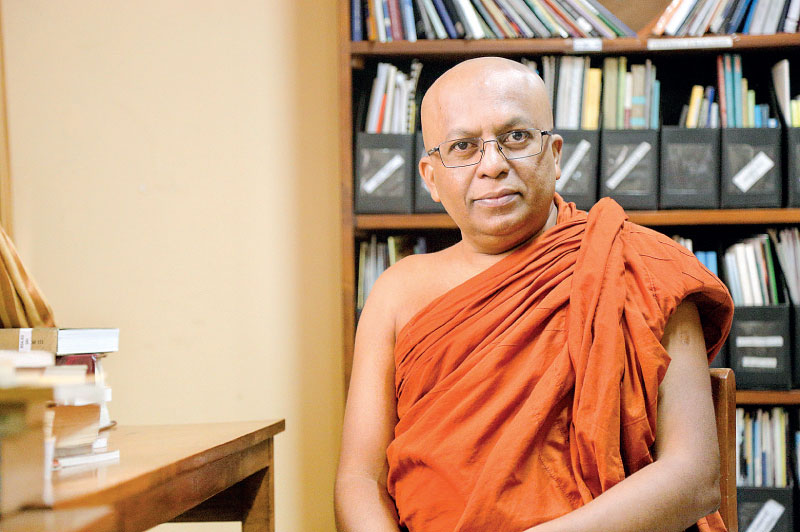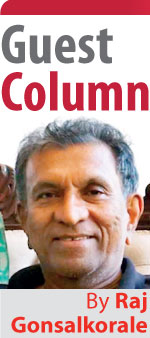Sunday Apr 20, 2025
Sunday Apr 20, 2025
Thursday, 21 October 2021 01:11 - - {{hitsCtrl.values.hits}}

In the inaugural program of the rebranded WRI YouTube channel ‘Panshu,’ Ven. Dhammananda makes an enthralling presentation based on the Chulla Haththi Padopama Sutta which hopefully will leave viewers contemplating how well an ancient truism has been contextualised to a modern setting for its relevance today
|
 Social media today has linked millions of people with facts, fiction and outright fake news. It has influenced change of governments, election of presidents, royalty being found out and disgraced, scandals of every description doing the rounds faster than lightning, and instant messaging becoming integral to the life of millions.
Social media today has linked millions of people with facts, fiction and outright fake news. It has influenced change of governments, election of presidents, royalty being found out and disgraced, scandals of every description doing the rounds faster than lightning, and instant messaging becoming integral to the life of millions.
Most do not ascertain the veracity of information that is circulating, which can easily be done in most cases by doing a quick internet search, but simply and irresponsibly, have become fodder for social media giants in the market who have reaped millions of dollars as a consequence.
A bleak world
It is debateable whether instant information dissemination has made the world a better place for human beings and whether their quality of life has improved. Following statistics presents a considerably bleak world.
That is the reality of the world that is interconnected before one can blink an eyelid! As of January 2021 it has been reported that there were 4.66 billion active internet users worldwide – 59.5% of the global population. Of this total, 92.6% (4.32 billion) accessed the internet via mobile devices. https://www.statista.com/statistics/617136/digitalpopulationworldwide/#:~:text=How%20many%20people%20use%20the,the%20internet%20via%20mobile%20devices.
The power of the internet has given enormous mind changing powers to social media giants, but as mentioned at the outset here, it is highly debateable whether this power has been harnessed to improve the quality of life for people and whether instant messaging has, in effect, brought people closer to one another.
A discussion on this topic could very well be both esoteric and fruitless; understood and appreciated by a few, and of not much consequence to many. It is this statement that has relevance to the effort of Venerable Galkande Dhammananda and the Walpola Rahula Institute, in introducing a fundamental tenant of what Buddha had taught more than 2,500 years ago.
Chulla Haththi Padopama Sutta
In the inaugural program of the rebranded WRI YouTube channel ‘Panshu,’ Ven. Dhammananda makes an enthralling presentation based on the Chulla Haththi Padopama Sutta which hopefully will leave viewers contemplating how well an ancient truism has been contextualised to a modern setting for its relevance today.
It is said that of many Suttas diversely found in the Buddhist text, Arahat Mahinda chose Chulla Haththi Padopama Sutta as the first discourse seed to feed Buddhist philosophy into King Devanampiyatissa (http://dailynews.lk/2021/06/24/features/252307/intellectual-discourse-led-new-social-foundation).
It is highly relevant that today, in the age of a world so instantly linked to one another, to relive what the Buddha himself extolled, and later Ven. Mahinda presented to the people of Sri Lanka during his visit more than 2000 years ago, and now, what Ven. Dhammananda presents to the contemporary world.
Buddhism a guide to making better decisions
The following is adopted from Venerable Dhammananda’s presentation on this inaugural Panshu program and begins with the question whether Buddhism provides a guide to evaluate a situation before arriving at better decisions after critical inquiry. The answer is: yes, it does.
Quote: “Before we introduce the Buddhist model of decision making, let us familiarise ourselves with two general decision-making models that exist in society – the Pilotika model and the Janussoniya model. One day, Pilotika and Janussoniya met on the streets. Hearing from Pilotika that he is returning from an audience with Buddha, Janussoniya inquires whether Buddha is a noble person. Pilotika replies in the affirmative. Janussoniya then questions how Pilotika decided that Buddha is noble. Pilotika›s answer is quite important. He says: I decided that Buddha is noble because I saw expert debaters coming to debate with Buddha, having prepared extensively. However, upon a brief conversation, they gave up their prepared debating points, agreed with Buddha, and even became followers of Buddha. Having seen this, I decided that Buddha is noble. Having heard Pilotika›s answer, Janussoniya gets down from the chariot, asks where Budda stayed and salutes in the direction of Buddha, praising his nobleness.
“Many of us make decisions following these two models. Pilotika›s decision of Buddha›s nobleness was not a result of consideration of Buddha›s discourse. It was simply a decision inspired by those Pilotika deemed to be important members of society.
“When an actor or actress you like promotes a particular soap to become beautiful, or a sportsperson promotes a specific type of milk to make you stronger, some people believe that to be the utmost truth. This kind of thinking follows the Pilotika model. Janussoniya model involves much less evaluation than even the Pilotika model. People following the Janussoniya model make decisions purely based on someone›s word. They would listen to the news telecast at night or someone›s recital of newspaper headlines in the morning and accepts that with no critical evaluation.
“Going back to the original story, after this incidence, Janussoniya meets Buddha and describes his conversation with Pilotika. This is when Buddha rejects both Pilotika and Janussoniya models and describes the proper way of arriving at a conclusion or making critically evaluated decisions – in the form of a story:
“A person entering a jungle observes a large footprint of an elephant. Having seen the sheer size of the impression, he decides that the print belongs to the ‹King Elephant› of the jungle. However, Buddha suggests that he should look for further signs as other elephants can also have large footprints. Then the person observes broken branches, high above in the canopy – suggesting the elephant›s height and the reach of its trunk. However, still, this is not enough proof for a conclusion. There could be other elephants as tall. Then he observes mud streaks on branches higher up, again suggesting strong evidence of a tall elephant. Yet, there could be other tall elephants. Search further. Next, he observes damages on tree trunks made by elephant tusks. These damages suggest the height, size of the tusks and the strength of the elephant. Although this is even more substantial proof, yet it›s not sufficient proof to draw a final conclusion. Lastly, he sees with his own eyes the ‹King Elephant› grazing the fields. Having seen with his own eyes, having confirmed what he has seen, only then can he conclude – teaches Buddha.
“This model demonstrates to us that you shouldn’t come to a conclusion just by mere sight or mere word. You should collect further proof; you should examine further. Finally, only after coming to a concrete understanding after critical evaluation should you arrive at a final conclusion.
“Practically, we may not be able to achieve a concrete understanding of everything in the world. We may need to stop at the footprint stage, broken branches stage, mud streak stage or the tusk damage stage. If we are in one of these stages, then our statements cannot be conclusive. Then it is essential to be aware that our understanding is incomplete.”
Venerable Dhammananda concludes thus: “You may now see that, in the ‘Buddha’ model of decision making, there is zero room for blind faith; that critical evaluation is held in high regard. Now, let us reflect. Do you belong to the Pilotika model, Janussoniya model or the Buddha model?” Unquote.
Nurturing critical thinking
The lesson for all is the need for nurturing critical thinking and to question information and its veracity. In explaining the thinking behind naming the new YouTube channel as Panshu, Ven Dhammananda said that the philosophy of the WRI has always had a positive outlook and it has focused on what could be done to have better outcomes, even over time, rather than just being disappointed with existing outcomes.
He said that on the one hand, Panshu may be considered as being basically all the elements of soil that graces the Earth’s surface and the final repository of everything that is material irrespective of who one is and their wealth. Ignorance of this fact, and being blinded by perceptions, unable to come to terms with reality and look at life more objectively, critically and with unconditional love to others, have left many disappointed and dissatisfied with what they currently have around them.
On the other hand, one could look at Panshu or soil, as being a fertile environment to grow new thinking, new ideas, and an avenue for renewal of ethical and moral values, so that outcomes, even if it takes time for fruition, will yield a more loving, compassionate, ethical and moral world. Ven Dhammananda said the WRI, through Panshu, will be providing opportunities for experiencing, questioning, and discussing and engaging in critical thinking through a variety of programs that are being designed as a pathway for a better future. “We reap what we sow, so, it is important to sow correct thinking so that we can reap a better future without just complaining about the present” he said.
The first program on Panshu may be accessed via https://www.youtube.com/watch?v=x9zc7JpA3cs.
Discover Kapruka, the leading online shopping platform in Sri Lanka, where you can conveniently send Gifts and Flowers to your loved ones for any event including Valentine ’s Day. Explore a wide range of popular Shopping Categories on Kapruka, including Toys, Groceries, Electronics, Birthday Cakes, Fruits, Chocolates, Flower Bouquets, Clothing, Watches, Lingerie, Gift Sets and Jewellery. Also if you’re interested in selling with Kapruka, Partner Central by Kapruka is the best solution to start with. Moreover, through Kapruka Global Shop, you can also enjoy the convenience of purchasing products from renowned platforms like Amazon and eBay and have them delivered to Sri Lanka.
Discover Kapruka, the leading online shopping platform in Sri Lanka, where you can conveniently send Gifts and Flowers to your loved ones for any event including Valentine ’s Day. Explore a wide range of popular Shopping Categories on Kapruka, including Toys, Groceries, Electronics, Birthday Cakes, Fruits, Chocolates, Flower Bouquets, Clothing, Watches, Lingerie, Gift Sets and Jewellery. Also if you’re interested in selling with Kapruka, Partner Central by Kapruka is the best solution to start with. Moreover, through Kapruka Global Shop, you can also enjoy the convenience of purchasing products from renowned platforms like Amazon and eBay and have them delivered to Sri Lanka.